Welcome to the first edition of @H2Spotlight, a new publication from the U.S. Department of Energy's (DOE's) Hydrogen and Fuel Cell Technologies Office (HFTO), with collaboration from other offices in the DOE Hydrogen Program.
HFTO's quarterly @H2News newsletter will continue to recap news, publications, opportunities, and events from the previous three months. @H2Spotlight supplements the newsletter with longer features and in-depth examination of happenings from across the DOE hydrogen community.
To view previous @H2News newsletters, please visit the archives.
In this issue:
Spotlights
Spotlight on Success: First Megawatt-Scale Demonstration of Hydrogen Fuel Cells for Data Center Backup Power
Earlier this year, Caterpillar Inc. announced successful completion of a first-of-a-kind collaboration with Microsoft and Ballard Power Systems to demonstrate the viability of using large-format hydrogen fuel cells to supply reliable and sustainable backup power for data centers.
The demonstration, hosted at Microsoft's Cheyenne, Wyoming, data center, simulated a 48-hour power outage, providing critical insights into the capabilities of fuel cell systems to power multi-megawatt data centers, ensuring uninterrupted power supply to meet 99.999% uptime requirements.
Caterpillar served as project lead, providing overall system integration, power electronics, and microgrid controls that form the central structure of the hydrogen power solution. Hardware for the demonstration included two Caterpillar power grid stabilization storage systems alongside a 1.5-MW hydrogen fuel cell supplied by Ballard Power Systems. Over the course of the project, researchers evaluated the cost and performance of the fuel cell system including analysis of key performance characteristics such as power transfer time and load acceptance.
Launched in 2020 and completed this year, the project was supported and partially funded by DOE under the H2@Scale initiative, which brings stakeholders together to advance affordable hydrogen production, transport, storage, and utilization in multiple energy sectors. During the demonstration, researchers at DOE's National Renewable Energy Laboratory (NREL) analyzed safety, techno-economics, and greenhouse gas impacts.
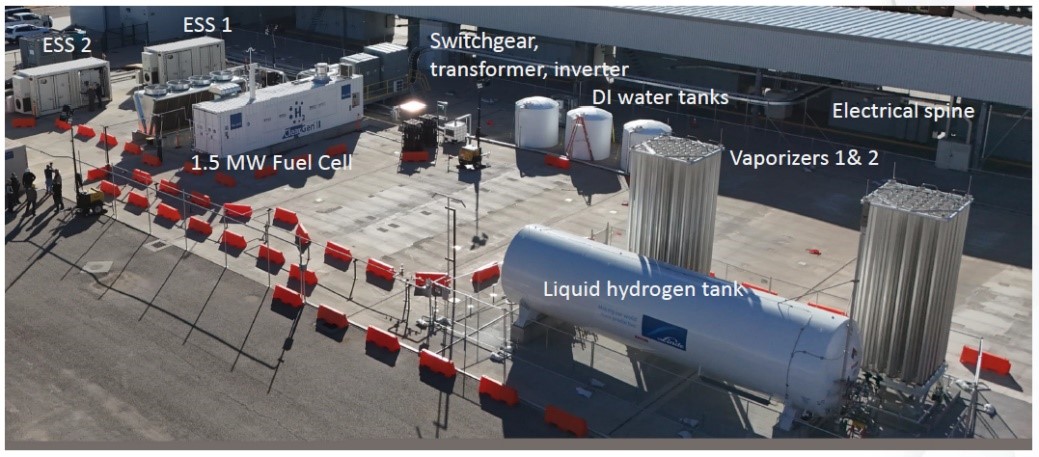
February H2IQ Hour: Hydrogen Fuel Cell Generator Demonstration at Microsoft Data Center
HFTO recognized the project at the Hydrogen Program's Annual Merit Review and Peer Evaluation Meeting in May 2024, presenting Caterpillar and its research partners with a Systems Development and Integration award. HFTO Director Dr. Sunita Satyapal noted that the project's success proves enormously valuable for market applications, as data centers nationwide seek sustainable solutions to address emissions reduction and rising energy demand.
Caterpillar also leads a project with Minnesota-based District Energy St. Paul to demonstrate a hydrogen-fueled combined heat and power system.
Recap: National Hydrogen and Fuel Cell Day 2024
Did you get your steps in—1.008 miles to be exact—on October 8? HFTO staffers certainly did, alongside many colleagues and friends from across the DOE hydrogen community in both Washington D.C. and Golden, Colorado.
National Hydrogen and Fuel Cell Day 2024 kicked off at DOE headquarters with words of inspiration from Energy Secretary Jennifer Granholm before turning things over to Smithsonian Gardens Horticulturist Shelley Gaskins, who led a large group of hydrogen enthusiasts through a guided tour of garden highlights on the 1.008-mile stroll.
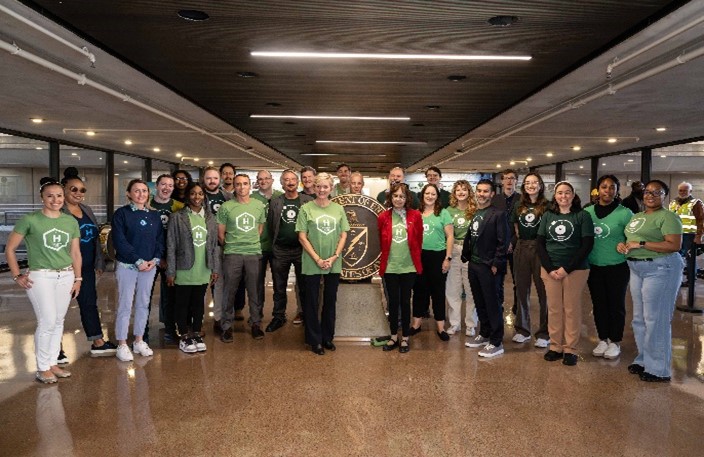
Hydrogen Week 2024—Celebrating National Hydrogen and Fuel Cell Day All Week Long!
HFTO's Colorado-based colleagues also hosted a sun-drenched 1.008 mile walk through NREL's picturesque campus. Eyes were peeled, but no rattlesnakes were spotted on the walk (fun fact: the Prairie Rattlesnake is the unofficial mascot of NREL's Golden campus).
HFTO invited stakeholders and the public to celebrate Hydrogen Day all week long—on that note, it's never too late to take the updated hydrogen quiz and test your H2 IQ!
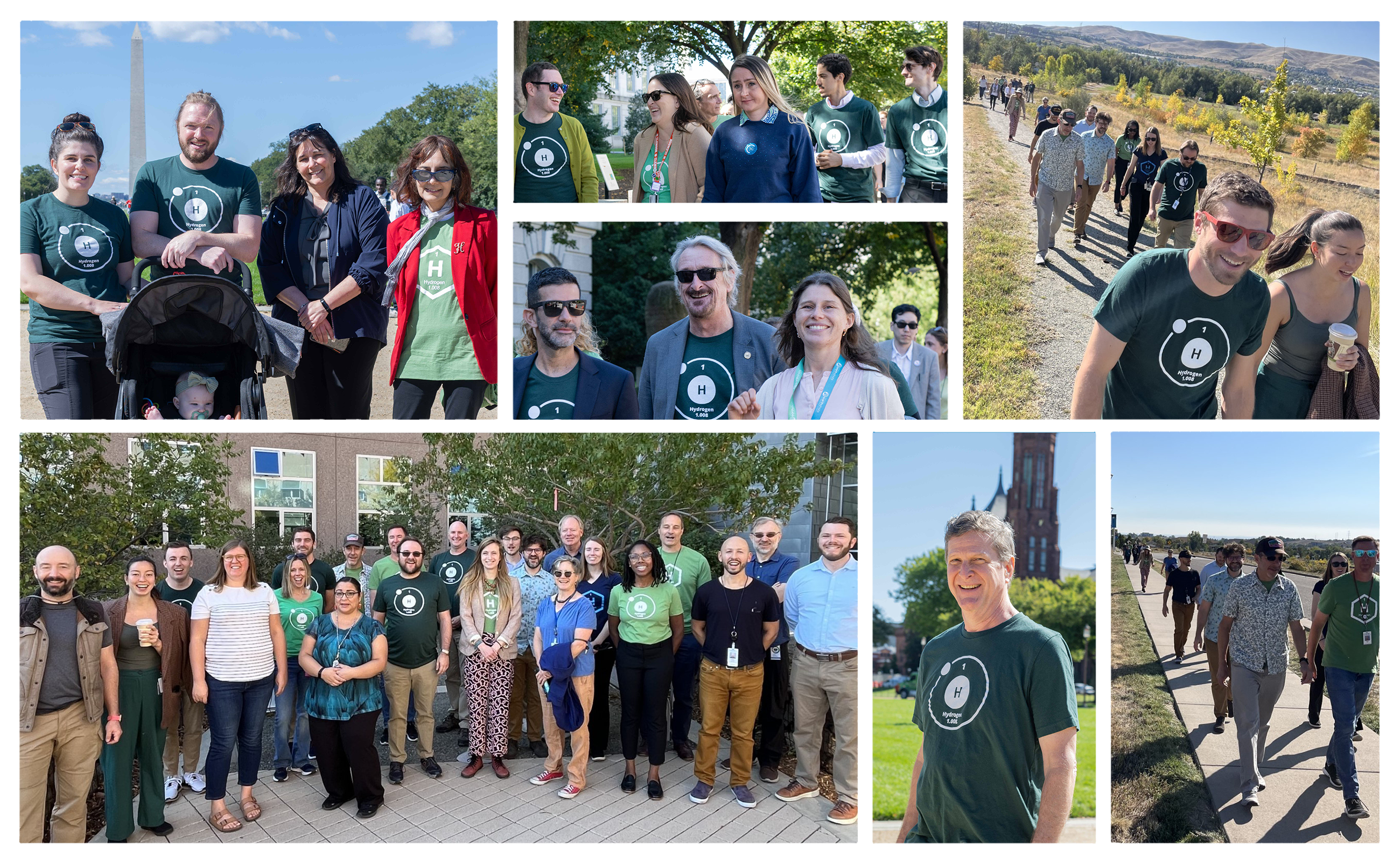
National Hydrogen and Fuel Cell Week: The Business of Hydrogen Takes the Spotlight at Cheyney University of Pennsylvania
As many of our stakeholders are aware, each year DOE celebrates National Hydrogen and Fuel Cell Day for a full week—through announcements, social media blasts, and special events. This year, the U.S. Small Business Administration (SBA), supporting engagement goals set forth by the Hydrogen Interagency Taskforce, organized a Hydrogen Week-themed small business/startup forum October 11 at Cheyney University of Pennsylvania, the oldest of our nation's historically black colleges and universities.
Cheyney University President Aaron A. Walton kicked off the event and was joined by SBA Deputy Administrator Dilawar Syed and HFTO Director Dr. Sunita Satyapal.
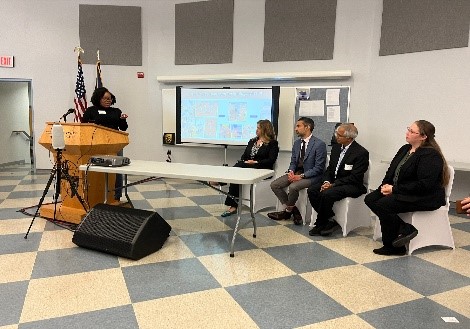
The forum provided the Cheyney University community with direct access to a panel of small businesses focused on building the hydrogen economy and advancing clean energy technologies in the greater Philadelphia region—including PDC Machines, OxEon Energy, Versogen, and NanoSonic.
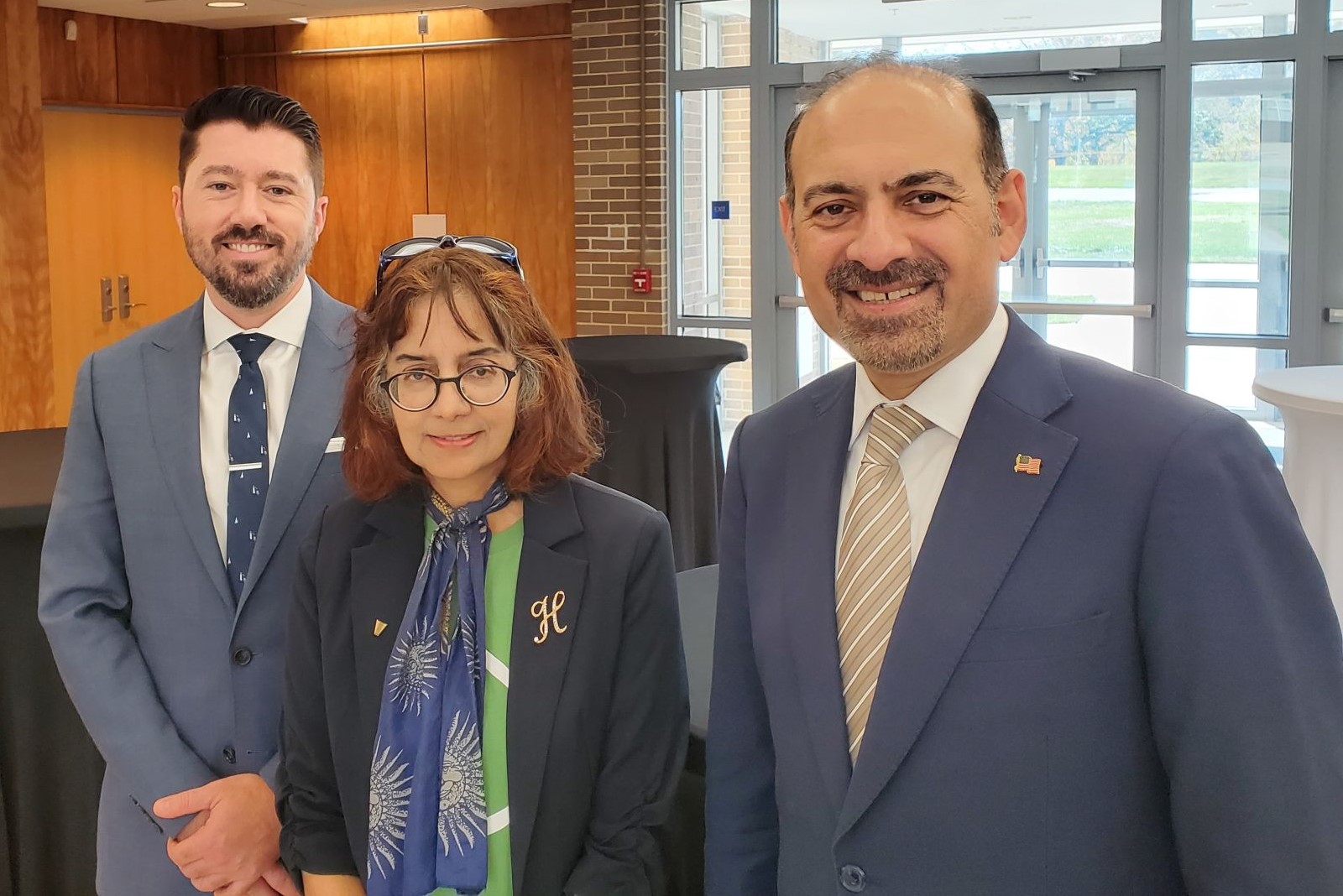
Panel topics included prioritization of workforce development and retention, pathways to business growth and cost-effective scaling for clean hydrogen manufacturing, and the current state of hydrogen demand and marketing efforts to support demand-side initiatives.
Discussions and questions further explored the necessity and value of collaboration, and the need to improve the clarity of projections for market growth and other outcomes.
National Hydrogen and Fuel Cell Week: Lincoln Financial Field in Philadelphia Paves the Way for Hydrogen Fueling
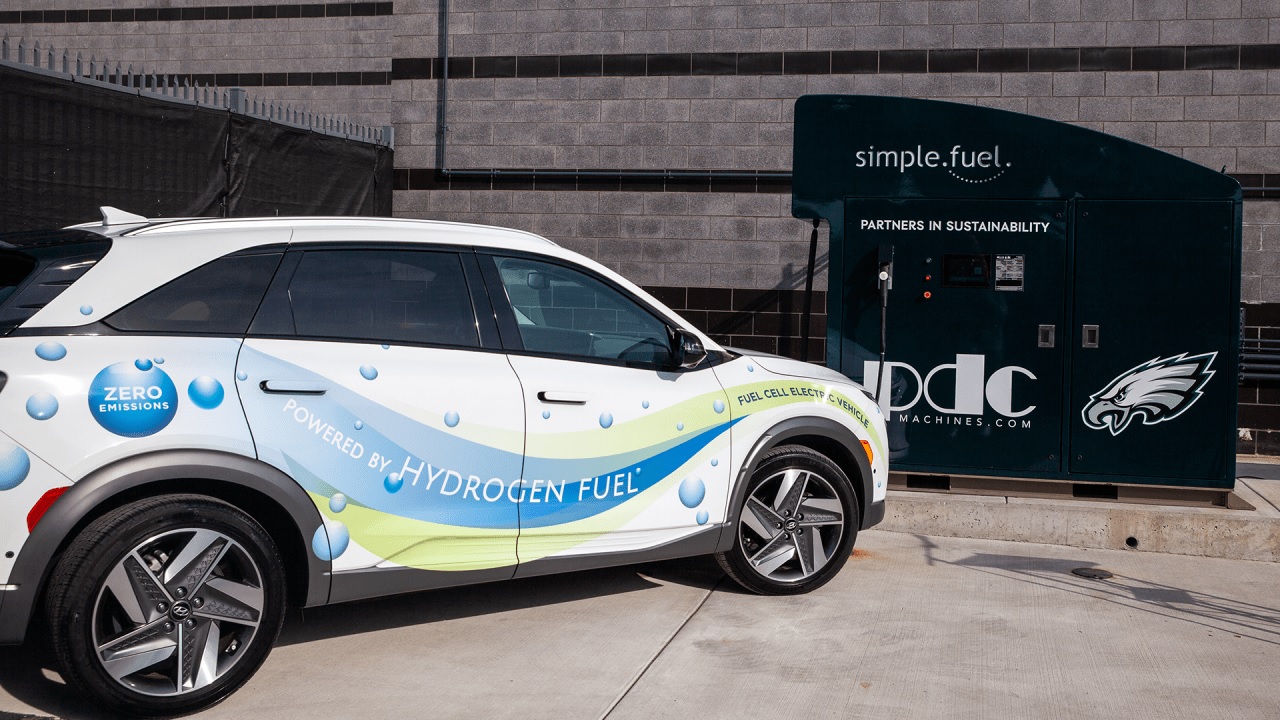
Touchdown for clean hydrogen! The National Football League's Philadelphia Eagles are the first professional sports team in North America to use clean hydrogen produced on-site.
As part of National Hydrogen and Fuel Cell Week 2024, HFTO Director Dr. Sunita Satyapal joined DOE colleagues and representatives from the Eagles organization on October 11 to celebrate the new station—a SimpleFuel station located next to Lincoln Financial Field.
The SimpleFuel Hydrogen Fueler is manufactured by PDC Machines, a recipient of HFTO funding. It can produce up to 10 kilograms of clean hydrogen per day and can support both trucks and passenger vehicles powered by fuel cells. With over 10,000 solar panels installed across the stadium, the addition of SimpleFuel is the latest in a series of green initiatives undertaken by the Eagles organization.
The visit to Lincoln Financial Field was the culmination of a long and fruitful collaboration between DOE and the minds behind SimpleFuel. It began in 2017, when three companies, including PDC, hatched an idea for a simple, small-scale hydrogen fueling station that integrates an electrolyzer, compressor, storage tanks, and dispenser in a single self-contained unit. In 2017, the SimpleFuel concept claimed the $1 million prize in DOE's H2 Refuel H-Prize Competition. On the strength of this funding and the recognition of DOE experts, SimpleFuel made the leap from concept to commercialization.
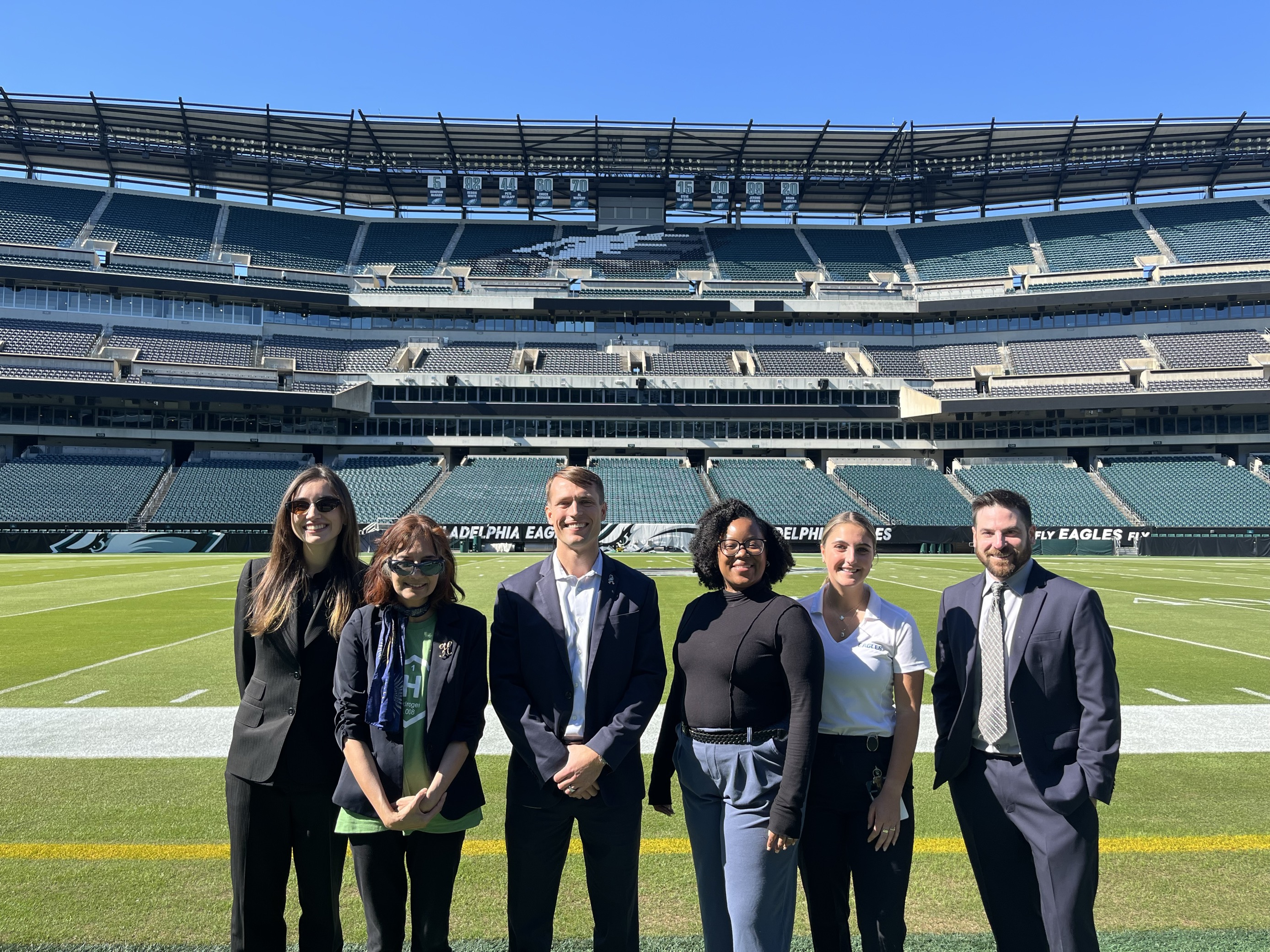
Fuel, Eagles, Fuel
DOE and its partners celebrate the installation of a new hydrogen fueling station at Lincoln Financial Field.
Hydrogen Insider
NSF Hydrogen INTERN Program Announces Six Student Selectees to Help Advance Hydrogen and Fuel Cell Innovation
For promising university students, engagement with real-world research efforts can provide a launching point for STEM-focused careers. The National Science Foundation (NSF), in collaboration with DOE, leads a series of INTERN programs across multiple STEM fields to provide students with cornerstone research opportunities.
NSF recently announced that six students were selected for the Hydrogen INTERN program, supporting eight projects across three NSF directorates: engineering, geosciences, and mathematics/physical sciences. Selectees include the following:
With support from Idaho National Laboratory, Coskunuzer will evaluate the role of hydrogen in enhancing power grid resilience, efficiency, and sustainability aligning with HFTO’s systems development and integration goals.
Fei will work with the fuel cell group at Los Alamos National Laboratory on the design of catalysts for fuel cells.
With support from Oak Ridge National Laboratory, Kadambi will focus on advancing the field of proton exchange membranes for the next generation of hydrogen fuel cells.
Matveev will work with Daimler North America to improve the efficiency of liquid-hydrogen-capable, long-haul, semi-tractor trailer trucks being developed in the commercial sector.
Monecke will work on three separate INTERN projects that will:
- Explore innovative ways to characterize geologic formations from around the world to quantify their hydrogen generating potential (Hitachi High-Tech).
- Analyze drill cores from various sedimentary basins for hydrogen storage potential (Norsk Elektro Optikk).
- Work with iron rich ultramafic drill core samples from northern Minnesota to investigate their potential for hydrogen generation (Hitachi High-Tech).
With support from De Nora Tech, Xu will focus on developing electrocatalyst materials to improve the performance and reduce the cost of catalyst-coated membranes.
HFTO extends a huge congratulations to each of these students and looks forward to seeing the outcomes of their research!
DOE Collaboration Strengthens Connections Between Fundamental and Applied Science in Clean Hydrogen
In recognition of last month’s National Hydrogen and Fuel Cell Day (October 8), HFTO and DOE's Office of Science highlighted H2LinkSC—a unique approach to strengthen connections between fundamental and applied science in hydrogen across the DOE national laboratories.
H2LinkSC connections are being established in various ways. One example is by giving lab researchers working on DOE initiatives—such as the Hydrogen Energy Earthshot, Energy Frontier Research Centers (EFRCs), and the Energy Earthshot Research Centers (EERCs)—the opportunity to propose and socialize novel ideas on how to maximize coordination and collaboration to accelerate research.
Dr. Geri Richmond

Former Under Secretary for Science and Innovation
"Supporting the rapid emergence of America’s clean energy economy—and the clean hydrogen economy specifically—requires an all-hands-on-deck approach," said DOE Under Secretary for Science and Innovation Dr. Geraldine Richmond. "H2LinkSC serves a crucial role in building connections between various research teams to catalyze and jointly improve fundamental and applied science approaches. These connections enhance and accelerate research, development, and demonstration outcomes and are vital to achieving our nation's clean energy mission."
Selected H2LinkSC projects focus on the synergies between fundamental and applied science to improve the performance and durability of next-generation electrolyzers and make progress toward DOE's Hydrogen Shot goal of $1 per one kilogram of hydrogen in one decade.
Learn more about H2LinkSC and related projects.
Coalition in Arvada, Colorado, Awarded $900,000 for Hydrogen Fleet Vehicle Demonstration
In November, DOE announced that a clean energy coalition in Arvada, Colorado (a suburb of Denver) will receive $900,000 to demonstrate the viability of hydrogen fleet vehicles. The project is part of a larger announcement that will drive innovation in clean transportation and provide first responders with the tools they need to properly respond to calls involving zero-emission vehicles. The funding will expand DOE's Clean Cities and Communities work to make clean transportation options more available, accessible, and affordable nationwide.
Projects will partner with over 45 of DOE's Clean Cities and Communities across more than 30 states to implement clean transportation projects in urban, suburban, and rural communities. The new investments support partnerships with local coalitions to provide outreach and technical assistance training to local communities, safety training and resources for emergency responders who work with zero-emission and electric vehicles, and support for demonstration and deployment of innovative clean transportation technologies.
This funding through DOE's Vehicle Technologies Office aligns with the goals of the National Blueprint for Transportation Decarbonization to fuel the economy, create good paying jobs, and expand access to cutting-edge technologies that reduce emissions and create healthier communities.
Around the Horn
EPA Announces Clean Ports Program Selections
The U.S. Environmental Protection Agency (EPA) recently announced the selection of 55 projects to receive nearly $3 billion in Clean Ports Program grants funded through the Inflation Reduction Act. This funding will support zero-emission port equipment and infrastructure as well as climate and air quality planning at U.S. ports located in 27 states and territories. Selectees include six port authorities focused on expanding the use of hydrogen-based equipment and technologies in port operations.
| Port Department of the City of Oakland | Oakland, CA | $322.1M |
| Illinois Environmental Protection Agency | Chicago, IL | $92.1M |
| Hawaii Department of Transportation | Honolulu, HI | $56.7M |
| Wayne County Port Authority | Detroit, MI | $3.0M |
| Don Young Port of Alaska | Anchorage, AK | $1.9M |
| South Carolina State Ports Authority | Charleston, SC | $1.3M |
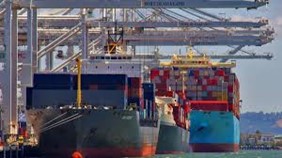
This new funding program was built on EPA's Ports Initiative, which helps our nation's ports—a critical part of America's infrastructure and supply chains—address public health and environmental impacts on surrounding communities.
In February 2024, EPA announced two separate funding opportunities for U.S. ports—a Zero-Emission Technology Deployment Competition to directly fund zero-emission port equipment and infrastructure to reduce mobile source emissions and a Climate and Air Quality Planning Competition to fund climate and air quality planning activities. The competitions closed in May 2024 with over $8 billion in requests from applicants across the country seeking to advance next-generation clean technologies at U.S. ports.
Department of Transportation Announces $96.6 Million in Hydrogen-Related Rail Projects in California, Colorado, and Pennsylvania
The U.S. Department of Transportation's Federal Railroad Administration (FRA) recently announced more than $2.4 billion in Bipartisan Infrastructure Law funding for 122 rail improvement projects in 41 states and Washington, D.C. This includes three projects in California, Colorado, and Pennsylvania to support deployment of hydrogen-related transportation technologies and applications.
Hydrogen-related projects include the following:
- $48.4 million to East Erie Commercial Rail in Pennsylvania for research and development of dual-fuel combustion engines using hydrogen and liquid hydrogen tenders. Testing at the Transportation Technology Center in Pueblo, Colorado, will help operators, first responders, and others learn how to safely handle hydrogen, as well as develop best practices for operating and maintaining hydrogen technology. Wabtec, Linde, and Greenbrier are also involved and will provide 20% cost sharing.
- $36.5 million to the California Air Resources Board to replace 10 diesel locomotives with nine battery-electric locomotives and one hydrogen fuel-cell locomotive, along with four battery chargers. Pacific Harbor Line will acquire five battery locomotives and two chargers; Watco will require four battery locomotives and two chargers, and the Sacramento Valley Railroad will acquire the hydrogen locomotive.
- $11.7 million to Colorado State University-Pueblo for safety experiments and testing of rail vehicles powered by compressed hydrogen and compressed natural gas. The University of Hawaii and OptiFuel are partners and will contribute 36% cost sharing.
According to FRA officials, these projects will make rail safer, more reliable, and more resilient, getting goods and people where they need to be quickly with fewer disruptions, lower shipping costs, and less pollution.
Geologic Hydrogen Continues to Gain Momentum
Research investigations into geologic hydrogen—considered a "horizon" activity just a decade ago—are revealing significant promise in terms of access to large, viable deposits of naturally-occurring hydrogen beneath the Earth's surface. These models are now being used to plan for exploration in prospective fairways.
The University of Alaska-Fairbanks hosted a workshop October 29–31 to launch discussions into pursuing geologic hydrogen development in Alaska as part of a statewide pivot to incorporate greater access to clean energy resources. The workshop, co-hosted by the U.S. Arctic Research Commission, included attendees from various universities, Alaska Native corporations, private sector operators, and the White House Office of Science and Technology Policy.
Earlier this year, DOE's Advanced Research Projects Agency-Energy (ARPA-E) announced $20 million in funding for 16 projects across eight states for exploratory research into (1) production of geologic hydrogen through stimulated mineralogical processes, and (2) subsurface engineering for hydrogen reservoir management. In addition to these 16 projects, Argonne National Laboratory's Systems Assessment Center was tapped to develop a methodology for life cycle analysis of geologic hydrogen via the Greenhouse gases, Regulated Emissions, and Energy use in Technologies (GREET) model. GREET is widely used for assessing the energy consumption, greenhouse gas emissions, criteria air pollutant emissions, and water consumption of various energy, material, and vehicle technologies.
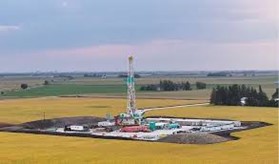
Koloma natural hydrogen site
Image courtesy of Mitsubishi Heavy Industries
In October, Mitsubishi Heavy Industries joined Breakthrough Energy, Amazon's Climate Pledge Fund, and United Airlines in investing in Koloma, a Denver-based startup that plans to identify and commercialize geologic hydrogen globally. Koloma has raised $245 million in Series B capital funding. Koloma co-founder Pete Johnson describes geologic hydrogen as a "skeleton key" for decarbonization, noting that it could be the world's first new primary energy source in 100 years.
Rochester’s Regional Transit Service Adds New York's First Hydrogen Fuel Cell Buses
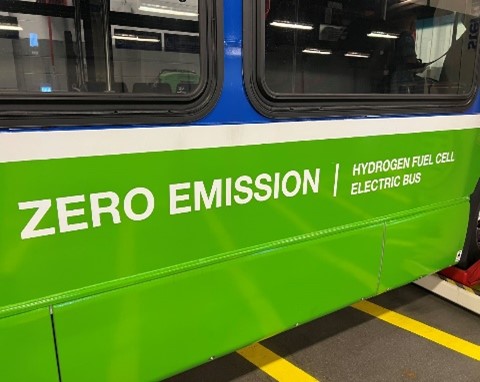
Regional Transit Service (RTS) in Rochester, New York added two hydrogen fuel cell electric buses to its fleet, marking the first hydrogen fuel cell electric buses operating in the state.
According to RTS officials, these new buses enhance service and range by extending drive times between fueling—even in cold weather, they can drive more than 300 miles on a single fill, with only 10 minutes required to refuel.
RTS is working towards the goal of having a 100% zero-emissions bus fleet by 2040, as set forth by an executive order signed by New York Governor Kathy Hochul in 2022. RTS's journey to a zero-emissions fleet started in 2017 when New York State announced grant funding for the first five plug-in battery electric buses in the RTS fleet. Since then, RTS has added 20 battery electric buses and now, two hydrogen fuel cell buses to its fleet.
Additional buses will be added to the fleet in the future. Since 2022, RTS has received $35.1 million in hydrogen fuel cell-related grant funding for twelve 40-foot hydrogen fuel cell electric buses, five hydrogen fuel cell electric Ford Transit vans, one portable hydrogen refueler, and hydrogen-related facility upgrades.
Critical Materials Community Unveils New Quarterly Newsletter
Exciting news! DOE's Critical Materials Collaborative (CMC) recently launched its first-ever quarterly newsletter. The CMC is a network of DOE offices (including HFTO), federal agencies, and research community members designed to enhance communication and coordination across the critical materials innovation ecosystem. Created for the critical materials community, this quarterly newsletter will keep you informed of the latest CMC activities, funding opportunities, key events, and more within DOE and our partner agencies.
***
Stay current with hydrogen and clean energy news!
- Subscribe to Hydrogen and Fuel Cell News from HFTO to stay up to date on hydrogen and fuel cell news and funding opportunities.
- Subscribe to EERE's Weekly Jolt for the latest clean energy news from DOE's Office of Energy Efficiency and Renewable Energy.

